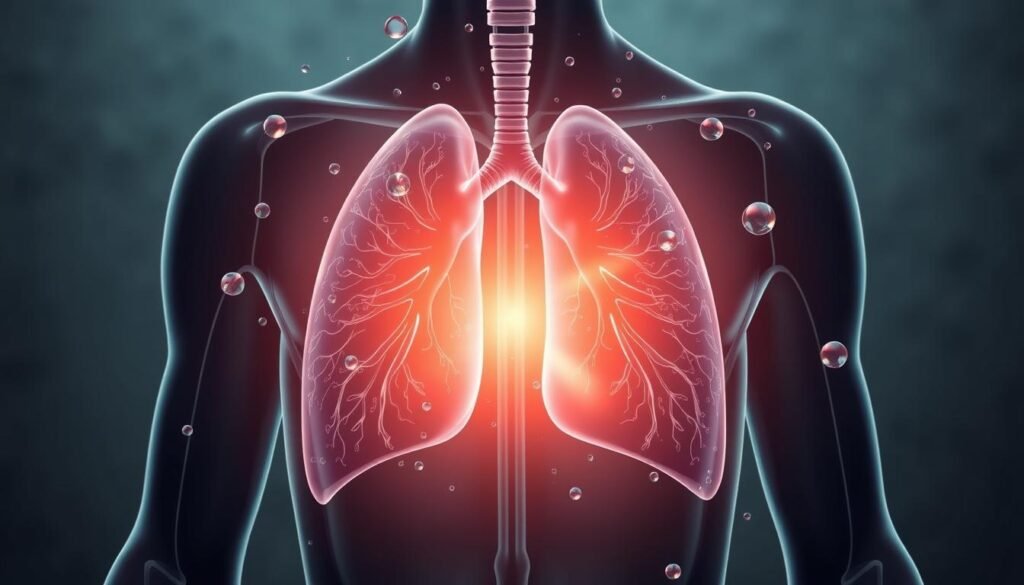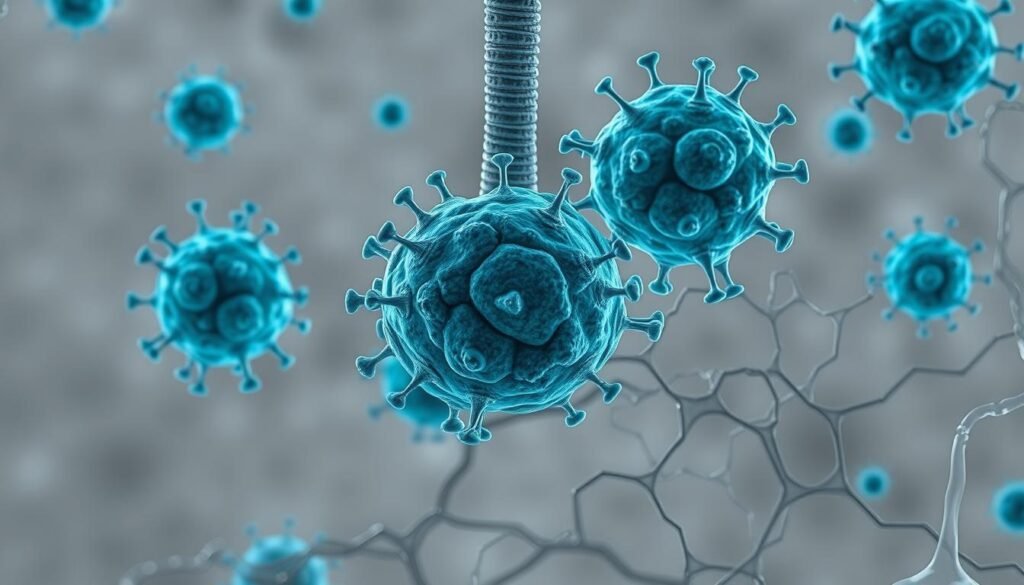About 25% of people with small cell lung cancer (SCLC) deal with SIADH. This is a big number, and it shows how common this cancer complication is. SIADH not only affects many but also changes how long lung cancer patients might live. Knowing about the link between SIADH and lung cancer helps with quick diagnosis and the right treatment.
This guide will tell you what you need to know about SIADH’s symptoms, causes, how to find out if someone has it, and how to treat it. It’s made to help those caring for others and patients to be well informed about this important health issue.
Key Takeaways
- SIADH affects approximately 25% of SCLC patients, complicating their treatment and care.
- Diagnosis can involve various blood and urine tests to monitor sodium levels.
- Treatment strategies may include fluid restrictions and specific medications to manage symptoms.
- Addressing the underlying lung neoplasm could help prevent recurrent SIADH.
- Effective management of SIADH can improve the prognosis and quality of life for affected patients.
Introduction to SIADH and Lung Cancer
SIADH lung cancer poses a major issue, mainly in patients with small-cell lung cancer (SCLC). Tumors release too much antidiuretic hormone (ADH), causing fluid and sodium level imbalances. It’s crucial to understand this for effective cancer care and improving patient outcomes.
Hyponatremia is a common issue in about 14% of cancer patients in hospitals. It often points to bigger problems related to their cancer. Early spotting of symptoms and problems allows for better care.
Knowing how SIADH and lung cancer interlink is key during treatment. Medical experts must watch for SIADH signs to diagnose and treat it quickly. This helps lessen the impact on patients.
Being aware of early signs of lung cancer helps in grasping the connection with SIADH. With ongoing research into SIADH and lung cancer, staying pro-active in patient care is vital.
| Condition | Prevalence in Cancer Patients | Potential Symptoms |
|---|---|---|
| SIADH | 14% | Fatigue, confusion, headache |
| Hyponatremia | Common | Nausea, vomiting, seizures |
| Lung Cancer | Approximately 235,000 cases annually in the US | Cough, chest pain, weight loss |
Understanding SIADH: The Basics
SIADH is when your body makes too much antidiuretic hormone (ADH). This causes water to stay in the body. When there’s too much water, the sodium in our blood gets diluted. This is called hyponatremia. How bad hyponatremia gets can depend on how fast sodium levels fall.
Several medical issues can cause SIADH. This includes some tumors that make ADH, like lung cancer. Treatments for cancer can also trigger it. It’s important to know what’s causing it because it can seriously affect health. It might cause symptoms that affect the brain and body.
SIADH can lead to dangerous problems. Too much water in the body can cause the brain to swell, heart failure, or seizures. To manage SIADH, doctors work on the root cause. They also fix the sodium levels carefully to prevent more issues.

What is the Syndrome of Inappropriate Antidiuretic Hormone?
The Syndrome of Inappropriate Antidiuretic Hormone (SIADH) happens when too much antidiuretic hormone is released. This problem can lead to severe health issues. It’s common in people with diseases, especially cancer patients, because tumors might produce these hormones.
This syndrome can make the kidneys keep too much water. Medicines, surgery with general anesthesia, and certain brain diseases can trigger it. Lung diseases, like pneumonia, are also linked to it. An important point is that about 24% of SIADH cases are related to cancer.
To diagnose SIADH, doctors use blood and urine tests. They check levels of sodium, potassium, and osmolality. These tests help to confirm the diagnosis. Spotting it early is key to avoid serious problems, such as confusion, nausea, and seizures.
Treatments depend on what’s causing the issue and might include limiting fluids or changing medicines. In extreme cases, IV salt solutions help manage symptoms. This shows why quick medical help is important. Knowing about SIADH definition and its disease links raises awareness of this dangerous condition.
SIADH Lung Cancer: Symptoms and Impact on Health
SIADH is a big problem for lung cancer patients, especially those with small-cell lung cancer. These patients often have low sodium levels. This can cause nausea, confusion, headaches, muscle cramps, and very bad tiredness. If sodium levels fall too much, it might lead to seizures or coma. The worse the sodium drop, the more severe the symptoms.
Common Symptoms of SIADH
SIADH can make daily life hard for patients. It brings symptoms like:
- Nausea
- Confusion
- Muscle cramps
- Headaches
- Extreme fatigue
It’s important to watch sodium levels to keep quality of life. This helps avoid worse problems from low sodium.
How Symptoms Relate to Hyponatremia
Hyponatremia is common in lung cancer. It’s most frequent in those with small-cell lung cancer. About 19% of these patients experience low sodium. This can lead to bad outcomes, especially in late-stage cancer. Checking sodium regularly and managing it well can prevent worse cancer complications.

| Hyponatremia Severity | Symptoms | Sodium Levels (mEq/L) |
|---|---|---|
| Mild | Nausea, headache | 130-135 |
| Moderate | Confusion, muscle cramps | 125-129 |
| Severe | Seizures, coma | Below 125 |
For more info on SIADH and lung cancer, visit WebMD.
Causes of SIADH in Lung Cancer Patients
It is crucial to know why SIADH happens in lung cancer patients to manage it well. The syndrome is due to complex links between the cancer and its treatment.
The Role of Cancer Cells in ADH Production
Small-cell lung cancer often causes SIADH by making antidiuretic hormone (ADH) on its own. Neuroendocrine cancer cells can release ADH without the pituitary gland’s control. This leads to too much water in the body and hyponatremia.
In squamous-cell carcinoma, high calcium levels may play a role. But, the main issue is still too much ADH.
Impact of Cancer Treatments on SIADH
Treatment for cancer can make SIADH worse. Drugs for chemotherapy, like carboplatin, may cause it by affecting ADH or the kidneys. Also, certain anti-inflammatory drugs, SSRIs, and cyclophosphamide can increase ADH’s effects.
Knowing these factors is key to handling low sodium levels in lung cancer patients.

| Factor | Description |
|---|---|
| Small-Cell Lung Cancer | Most common cause of ectopic ADH production |
| Chemotherapy | Drugs like carboplatin associated with SIADH |
| Neuroendocrine Tumors | Can lead to excessive ADH secretion |
| Medications | SSRIs, cyclophosphamide may enhance ADH effects |
| Hyponatremia Incidence | Up to 50% in non-small-cell lung cancer patients |
Diagnosis of SIADH in Lung Cancer Patients
Identifying SIADH in lung cancer patients requires careful steps. Doctors start by testing for low sodium in the blood. This checks for hyponatremia, a key sign. An unusual sodium level might hint at deeper problems.
Initial Tests to Identify Hyponatremia
To diagnose SIADH, initial tests are vital. Doctors check:
- Serum sodium levels
- Urea nitrogen
- Creatinine
- Comprehensive blood chemistry
A sodium level under 135 mEq/L suggests hyponatremia. Low sodium levels require more examination.
Advanced Testing and Diagnosis Procedure
Advanced tests follow if SIADH seems possible. These include checking urine sodium and how concentrated it is. They help figure out why sodium levels are low and if SIADH causes it. For lung cancer patients, endocrinologists or oncologists read these results.
Doctors may also use imaging tests. They check for other causes of high ADH. This full check-up helps in accurately finding and handling SIADH. It guides the treatment plan.
| Test Type | What it Measures | Indication of SIADH |
|---|---|---|
| Serum Sodium | Concentration of sodium in the blood | Levels |
| Urine Sodium | Sodium concentration in urine | High levels indicate inappropriate ADH secretion |
| Urine Osmolality | Concentration of solutes in urine | Typically elevated in SIADH cases |
Treatment Options for SIADH in Lung Cancer
Managing SIADH in lung cancer patients needs a custom plan based on the hyponatremia level. They must watch sodium levels and change fluid intake. For mild to moderate cases, they might limit fluids and use meds like tolvaptan. This raises plasma sodium levels well.
Managing Mild to Moderate Hyponatremia
For those with mild to moderate SIADH, initial steps focus on controlling fluids. Steps include:
- Limiting fluid intake to lessen sodium dilution.
- Regularly checking serum sodium levels to see changes.
- Thinking about drugs like tolvaptan, effective in stabilizing sodium in patients.
Studies show tolvaptan quickly betters SIADH in patients. Specifically, in small cell lung cancer patients, plasma sodium maintenance exceeded 125 mmol/l for about 17.5 days. This highlights the strength of SIADH treatment methods including such drugs.
Severe Cases and Hospitalization Procedures
Severe hyponatremia needs urgent care, usually in a hospital. Here, giving saline through an IV is crucial. It carefully brings sodium levels back to normal and avoids risks like central pontine myelinolysis from too-quick sodium changes.
Severe cases can show symptoms like dizziness and agitation. Fast help is important to lessen these serious effects. With close watch in the hospital, they aim to safely raise sodium levels, no more than 10 mmol/l in 24 hours. This prevents brain damage.
The link between SIADH and lung cancer, especially in small cell lung cancer, is key. A big fraction of these patients are impacted. The effects on their health and life quality mean strict following of hyponatremia management rules is vital, notably in harsh cases.
| Condition | Management Strategy | Notes |
|---|---|---|
| Mild to Moderate Hyponatremia | Fluid restriction, Tolvaptan | Effective for maintaining sodium levels |
| Severe Hyponatremia | Hospitalization, IV saline | Avoid rapid sodium correction to prevent complications |
| Long-term Monitoring | Regular sodium checks, Lifestyle adjustments | Prioritize patient quality of life |
Long-term Management Strategies for SIADH
Long-term care for SIADH is key, especially for lung cancer patients. It’s crucial to regularly check sodium levels. These can change a lot, affecting health. Teams of doctors, like oncologists and endocrinologists, work together. They adjust treatments when needed. This team effort helps with fast action on symptoms and supports through the journey.
When dealing with low sodium, limiting fluids to 500-800 ml a day is the first step. There are also medicines that help the body get rid of water. These include loop diuretics, demeclocycline, and vasopressin blockers like tolvaptan. For those with SIADH, watching water intake and sodium in the diet is also key. These support overall wellbeing.
Regular check-ups and ongoing vigilance improve life quality and response to treatment. As SIADH can affect 7% to 16% of small-cell lung cancer patients, knowing how to manage it is essential. For more information on dealing with SIADH, check out this detailed overview. Adopting these long-term approaches helps lung cancer patients tackle SIADH’s challenges effectively.